Case Study of Complex Critical Care Patient with Urinary Tract Infection
VerifiedAdded on 2022/12/27
|9
|1974
|25
AI Summary
This document is a case study of a complex critical care patient suffering from urinary tract infection. It discusses the pathogenesis of urinary tract infection, nursing strategies to cure the patient, and analysis of arterial blood gas results. The document provides valuable insights into the diagnosis and treatment of urinary tract infections.
Contribute Materials
Your contribution can guide someone’s learning journey. Share your
documents today.
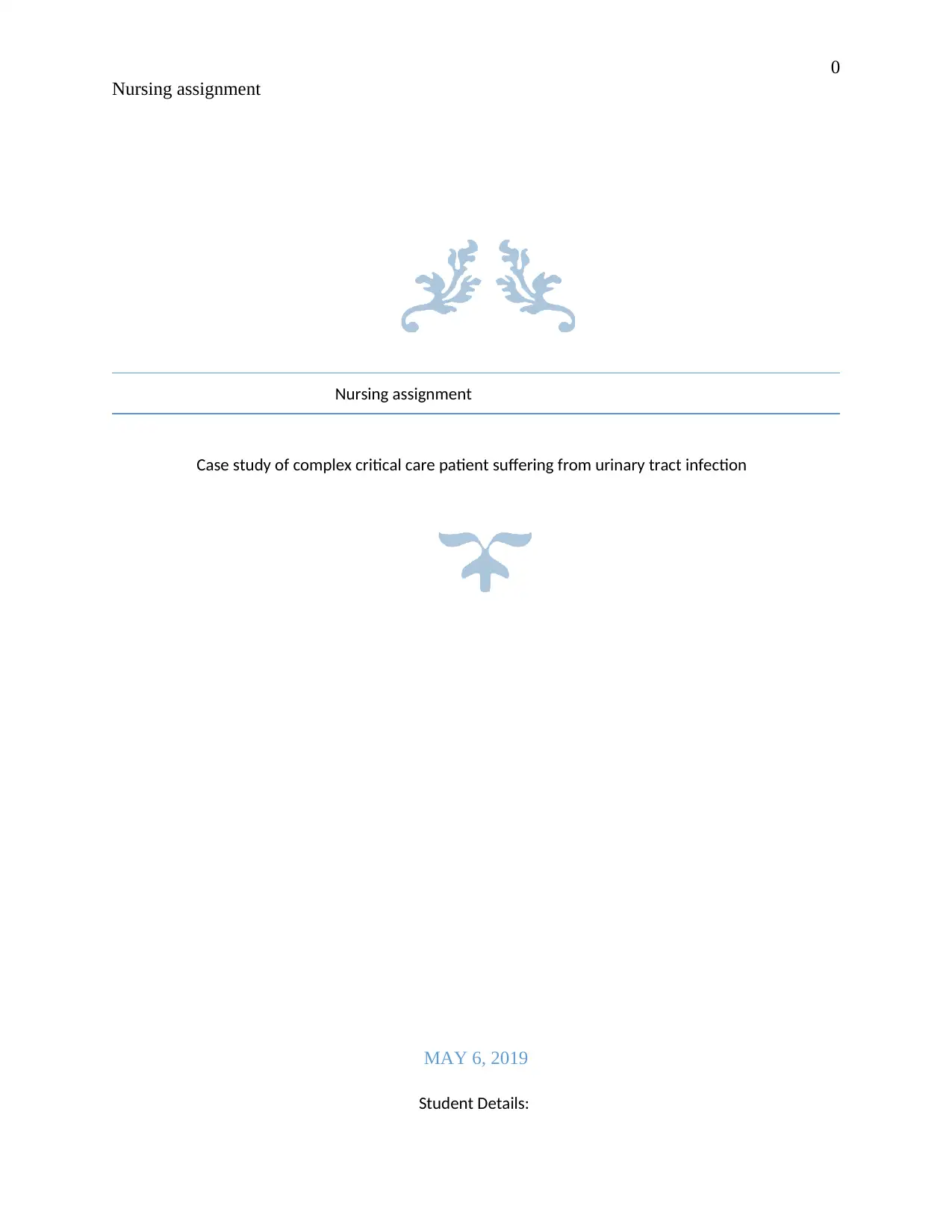
0
Nursing assignment
Nursing assignment
Case study of complex critical care patient suffering from urinary tract infection
MAY 6, 2019
Student Details:
Nursing assignment
Nursing assignment
Case study of complex critical care patient suffering from urinary tract infection
MAY 6, 2019
Student Details:
Secure Best Marks with AI Grader
Need help grading? Try our AI Grader for instant feedback on your assignments.
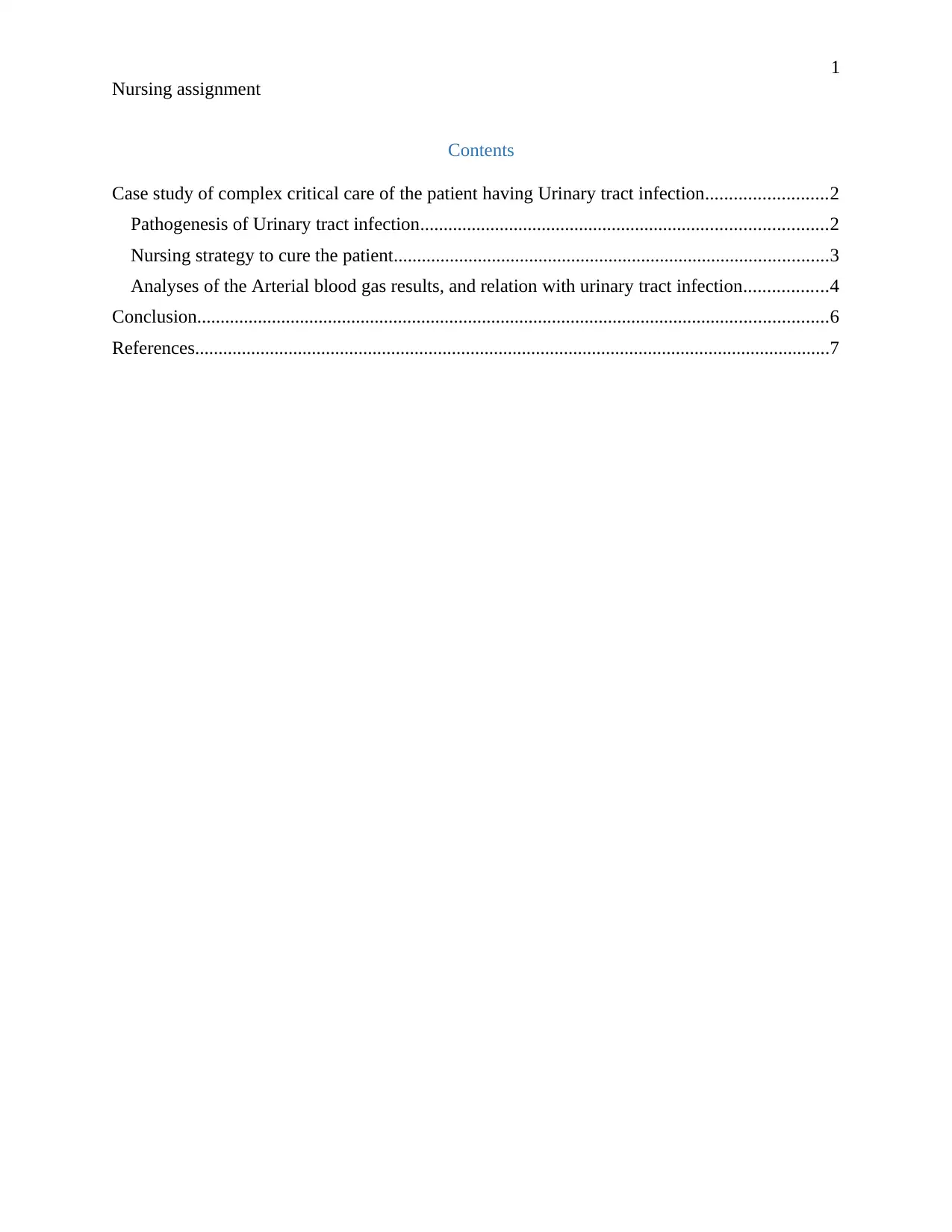
1
Nursing assignment
Contents
Case study of complex critical care of the patient having Urinary tract infection..........................2
Pathogenesis of Urinary tract infection.......................................................................................2
Nursing strategy to cure the patient.............................................................................................3
Analyses of the Arterial blood gas results, and relation with urinary tract infection..................4
Conclusion.......................................................................................................................................6
References........................................................................................................................................7
Nursing assignment
Contents
Case study of complex critical care of the patient having Urinary tract infection..........................2
Pathogenesis of Urinary tract infection.......................................................................................2
Nursing strategy to cure the patient.............................................................................................3
Analyses of the Arterial blood gas results, and relation with urinary tract infection..................4
Conclusion.......................................................................................................................................6
References........................................................................................................................................7
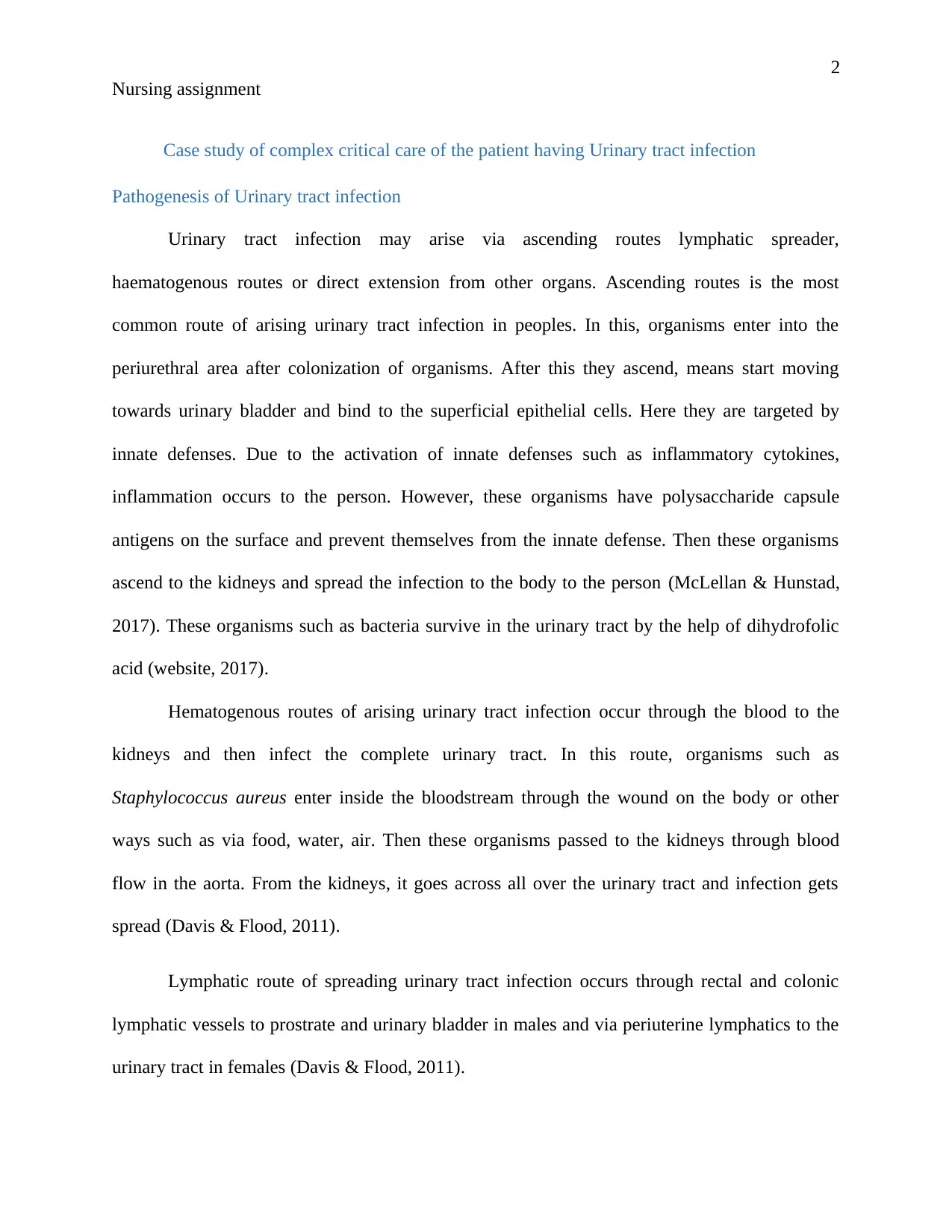
2
Nursing assignment
Case study of complex critical care of the patient having Urinary tract infection
Pathogenesis of Urinary tract infection
Urinary tract infection may arise via ascending routes lymphatic spreader,
haematogenous routes or direct extension from other organs. Ascending routes is the most
common route of arising urinary tract infection in peoples. In this, organisms enter into the
periurethral area after colonization of organisms. After this they ascend, means start moving
towards urinary bladder and bind to the superficial epithelial cells. Here they are targeted by
innate defenses. Due to the activation of innate defenses such as inflammatory cytokines,
inflammation occurs to the person. However, these organisms have polysaccharide capsule
antigens on the surface and prevent themselves from the innate defense. Then these organisms
ascend to the kidneys and spread the infection to the body to the person (McLellan & Hunstad,
2017). These organisms such as bacteria survive in the urinary tract by the help of dihydrofolic
acid (website, 2017).
Hematogenous routes of arising urinary tract infection occur through the blood to the
kidneys and then infect the complete urinary tract. In this route, organisms such as
Staphylococcus aureus enter inside the bloodstream through the wound on the body or other
ways such as via food, water, air. Then these organisms passed to the kidneys through blood
flow in the aorta. From the kidneys, it goes across all over the urinary tract and infection gets
spread (Davis & Flood, 2011).
Lymphatic route of spreading urinary tract infection occurs through rectal and colonic
lymphatic vessels to prostrate and urinary bladder in males and via periuterine lymphatics to the
urinary tract in females (Davis & Flood, 2011).
Nursing assignment
Case study of complex critical care of the patient having Urinary tract infection
Pathogenesis of Urinary tract infection
Urinary tract infection may arise via ascending routes lymphatic spreader,
haematogenous routes or direct extension from other organs. Ascending routes is the most
common route of arising urinary tract infection in peoples. In this, organisms enter into the
periurethral area after colonization of organisms. After this they ascend, means start moving
towards urinary bladder and bind to the superficial epithelial cells. Here they are targeted by
innate defenses. Due to the activation of innate defenses such as inflammatory cytokines,
inflammation occurs to the person. However, these organisms have polysaccharide capsule
antigens on the surface and prevent themselves from the innate defense. Then these organisms
ascend to the kidneys and spread the infection to the body to the person (McLellan & Hunstad,
2017). These organisms such as bacteria survive in the urinary tract by the help of dihydrofolic
acid (website, 2017).
Hematogenous routes of arising urinary tract infection occur through the blood to the
kidneys and then infect the complete urinary tract. In this route, organisms such as
Staphylococcus aureus enter inside the bloodstream through the wound on the body or other
ways such as via food, water, air. Then these organisms passed to the kidneys through blood
flow in the aorta. From the kidneys, it goes across all over the urinary tract and infection gets
spread (Davis & Flood, 2011).
Lymphatic route of spreading urinary tract infection occurs through rectal and colonic
lymphatic vessels to prostrate and urinary bladder in males and via periuterine lymphatics to the
urinary tract in females (Davis & Flood, 2011).
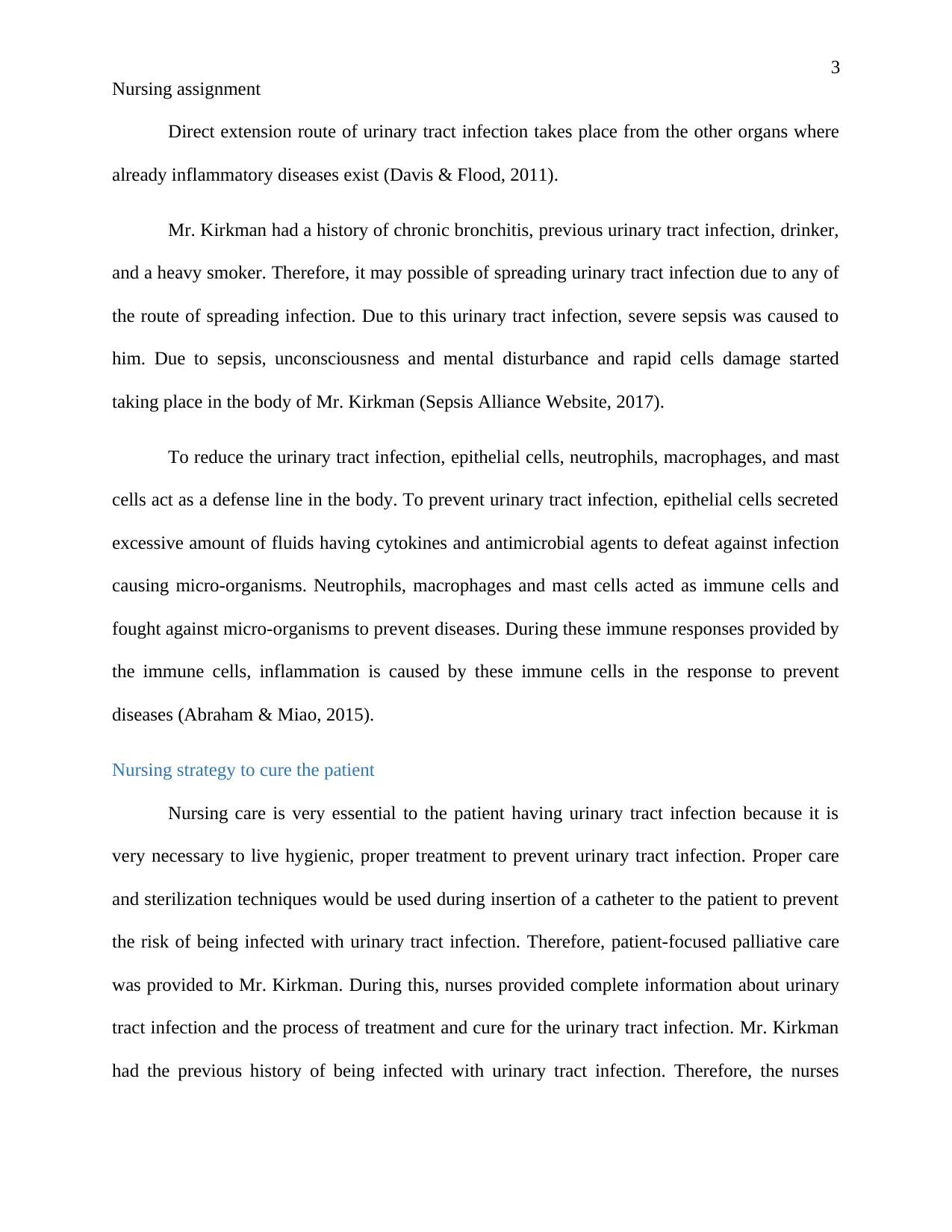
3
Nursing assignment
Direct extension route of urinary tract infection takes place from the other organs where
already inflammatory diseases exist (Davis & Flood, 2011).
Mr. Kirkman had a history of chronic bronchitis, previous urinary tract infection, drinker,
and a heavy smoker. Therefore, it may possible of spreading urinary tract infection due to any of
the route of spreading infection. Due to this urinary tract infection, severe sepsis was caused to
him. Due to sepsis, unconsciousness and mental disturbance and rapid cells damage started
taking place in the body of Mr. Kirkman (Sepsis Alliance Website, 2017).
To reduce the urinary tract infection, epithelial cells, neutrophils, macrophages, and mast
cells act as a defense line in the body. To prevent urinary tract infection, epithelial cells secreted
excessive amount of fluids having cytokines and antimicrobial agents to defeat against infection
causing micro-organisms. Neutrophils, macrophages and mast cells acted as immune cells and
fought against micro-organisms to prevent diseases. During these immune responses provided by
the immune cells, inflammation is caused by these immune cells in the response to prevent
diseases (Abraham & Miao, 2015).
Nursing strategy to cure the patient
Nursing care is very essential to the patient having urinary tract infection because it is
very necessary to live hygienic, proper treatment to prevent urinary tract infection. Proper care
and sterilization techniques would be used during insertion of a catheter to the patient to prevent
the risk of being infected with urinary tract infection. Therefore, patient-focused palliative care
was provided to Mr. Kirkman. During this, nurses provided complete information about urinary
tract infection and the process of treatment and cure for the urinary tract infection. Mr. Kirkman
had the previous history of being infected with urinary tract infection. Therefore, the nurses
Nursing assignment
Direct extension route of urinary tract infection takes place from the other organs where
already inflammatory diseases exist (Davis & Flood, 2011).
Mr. Kirkman had a history of chronic bronchitis, previous urinary tract infection, drinker,
and a heavy smoker. Therefore, it may possible of spreading urinary tract infection due to any of
the route of spreading infection. Due to this urinary tract infection, severe sepsis was caused to
him. Due to sepsis, unconsciousness and mental disturbance and rapid cells damage started
taking place in the body of Mr. Kirkman (Sepsis Alliance Website, 2017).
To reduce the urinary tract infection, epithelial cells, neutrophils, macrophages, and mast
cells act as a defense line in the body. To prevent urinary tract infection, epithelial cells secreted
excessive amount of fluids having cytokines and antimicrobial agents to defeat against infection
causing micro-organisms. Neutrophils, macrophages and mast cells acted as immune cells and
fought against micro-organisms to prevent diseases. During these immune responses provided by
the immune cells, inflammation is caused by these immune cells in the response to prevent
diseases (Abraham & Miao, 2015).
Nursing strategy to cure the patient
Nursing care is very essential to the patient having urinary tract infection because it is
very necessary to live hygienic, proper treatment to prevent urinary tract infection. Proper care
and sterilization techniques would be used during insertion of a catheter to the patient to prevent
the risk of being infected with urinary tract infection. Therefore, patient-focused palliative care
was provided to Mr. Kirkman. During this, nurses provided complete information about urinary
tract infection and the process of treatment and cure for the urinary tract infection. Mr. Kirkman
had the previous history of being infected with urinary tract infection. Therefore, the nurses
Secure Best Marks with AI Grader
Need help grading? Try our AI Grader for instant feedback on your assignments.
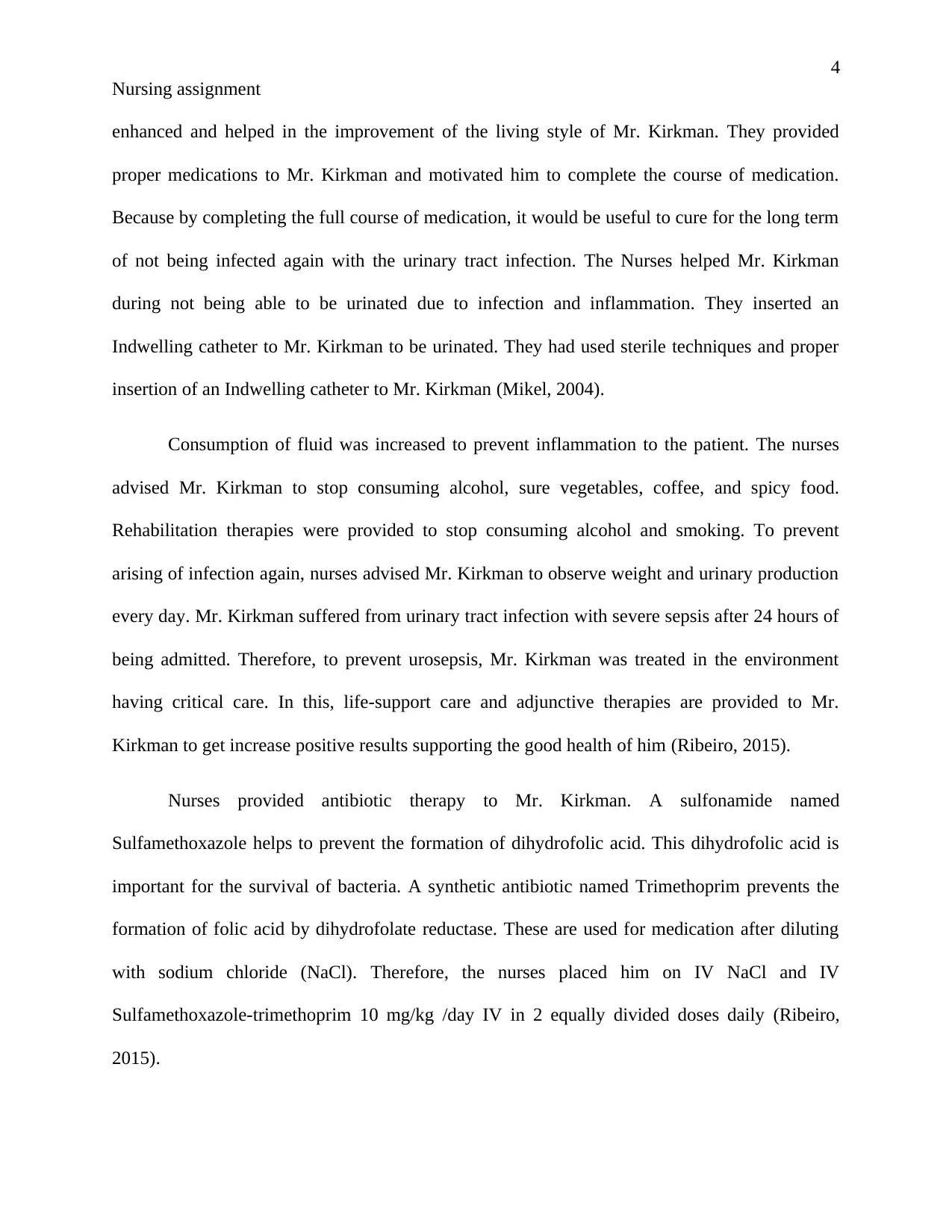
4
Nursing assignment
enhanced and helped in the improvement of the living style of Mr. Kirkman. They provided
proper medications to Mr. Kirkman and motivated him to complete the course of medication.
Because by completing the full course of medication, it would be useful to cure for the long term
of not being infected again with the urinary tract infection. The Nurses helped Mr. Kirkman
during not being able to be urinated due to infection and inflammation. They inserted an
Indwelling catheter to Mr. Kirkman to be urinated. They had used sterile techniques and proper
insertion of an Indwelling catheter to Mr. Kirkman (Mikel, 2004).
Consumption of fluid was increased to prevent inflammation to the patient. The nurses
advised Mr. Kirkman to stop consuming alcohol, sure vegetables, coffee, and spicy food.
Rehabilitation therapies were provided to stop consuming alcohol and smoking. To prevent
arising of infection again, nurses advised Mr. Kirkman to observe weight and urinary production
every day. Mr. Kirkman suffered from urinary tract infection with severe sepsis after 24 hours of
being admitted. Therefore, to prevent urosepsis, Mr. Kirkman was treated in the environment
having critical care. In this, life-support care and adjunctive therapies are provided to Mr.
Kirkman to get increase positive results supporting the good health of him (Ribeiro, 2015).
Nurses provided antibiotic therapy to Mr. Kirkman. A sulfonamide named
Sulfamethoxazole helps to prevent the formation of dihydrofolic acid. This dihydrofolic acid is
important for the survival of bacteria. A synthetic antibiotic named Trimethoprim prevents the
formation of folic acid by dihydrofolate reductase. These are used for medication after diluting
with sodium chloride (NaCl). Therefore, the nurses placed him on IV NaCl and IV
Sulfamethoxazole-trimethoprim 10 mg/kg /day IV in 2 equally divided doses daily (Ribeiro,
2015).
Nursing assignment
enhanced and helped in the improvement of the living style of Mr. Kirkman. They provided
proper medications to Mr. Kirkman and motivated him to complete the course of medication.
Because by completing the full course of medication, it would be useful to cure for the long term
of not being infected again with the urinary tract infection. The Nurses helped Mr. Kirkman
during not being able to be urinated due to infection and inflammation. They inserted an
Indwelling catheter to Mr. Kirkman to be urinated. They had used sterile techniques and proper
insertion of an Indwelling catheter to Mr. Kirkman (Mikel, 2004).
Consumption of fluid was increased to prevent inflammation to the patient. The nurses
advised Mr. Kirkman to stop consuming alcohol, sure vegetables, coffee, and spicy food.
Rehabilitation therapies were provided to stop consuming alcohol and smoking. To prevent
arising of infection again, nurses advised Mr. Kirkman to observe weight and urinary production
every day. Mr. Kirkman suffered from urinary tract infection with severe sepsis after 24 hours of
being admitted. Therefore, to prevent urosepsis, Mr. Kirkman was treated in the environment
having critical care. In this, life-support care and adjunctive therapies are provided to Mr.
Kirkman to get increase positive results supporting the good health of him (Ribeiro, 2015).
Nurses provided antibiotic therapy to Mr. Kirkman. A sulfonamide named
Sulfamethoxazole helps to prevent the formation of dihydrofolic acid. This dihydrofolic acid is
important for the survival of bacteria. A synthetic antibiotic named Trimethoprim prevents the
formation of folic acid by dihydrofolate reductase. These are used for medication after diluting
with sodium chloride (NaCl). Therefore, the nurses placed him on IV NaCl and IV
Sulfamethoxazole-trimethoprim 10 mg/kg /day IV in 2 equally divided doses daily (Ribeiro,
2015).
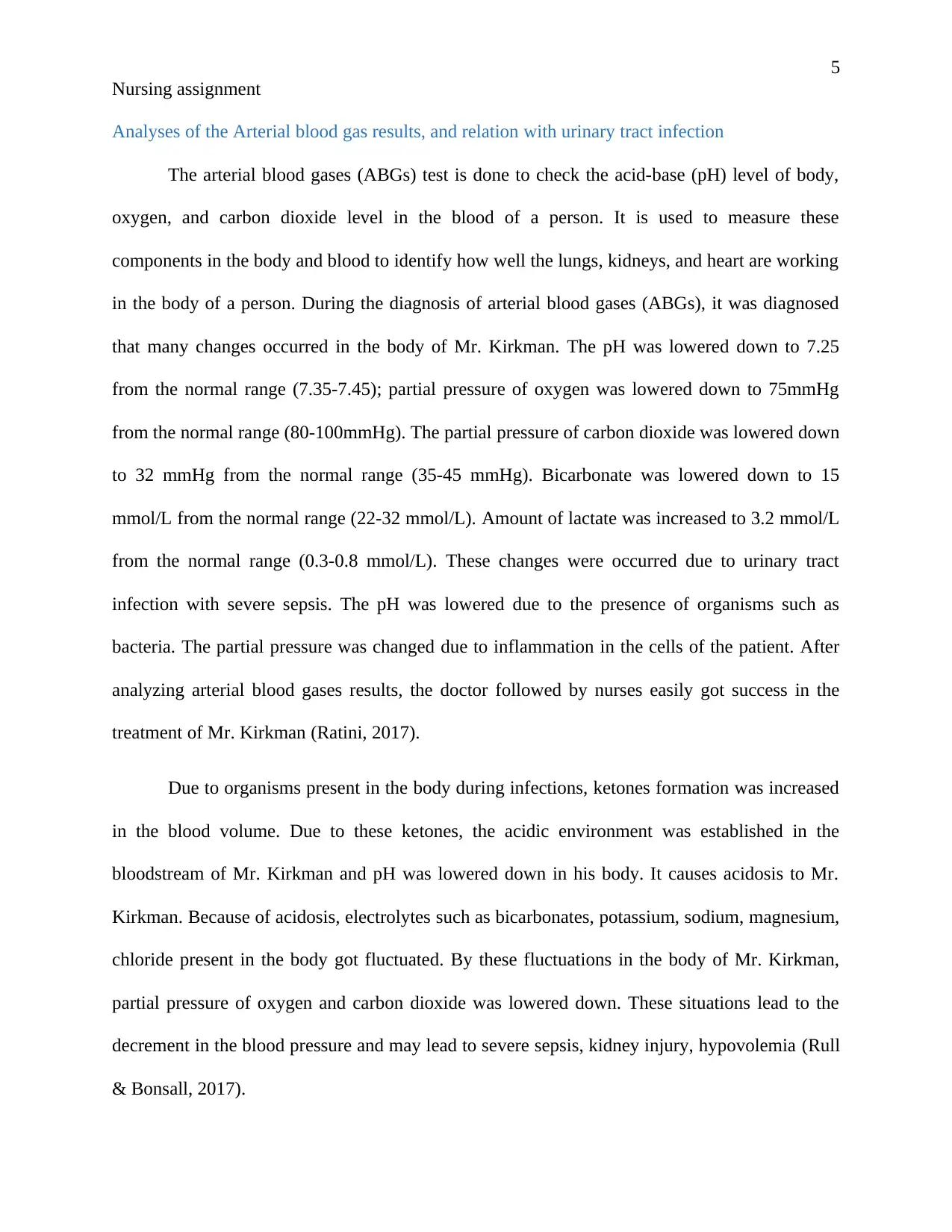
5
Nursing assignment
Analyses of the Arterial blood gas results, and relation with urinary tract infection
The arterial blood gases (ABGs) test is done to check the acid-base (pH) level of body,
oxygen, and carbon dioxide level in the blood of a person. It is used to measure these
components in the body and blood to identify how well the lungs, kidneys, and heart are working
in the body of a person. During the diagnosis of arterial blood gases (ABGs), it was diagnosed
that many changes occurred in the body of Mr. Kirkman. The pH was lowered down to 7.25
from the normal range (7.35-7.45); partial pressure of oxygen was lowered down to 75mmHg
from the normal range (80-100mmHg). The partial pressure of carbon dioxide was lowered down
to 32 mmHg from the normal range (35-45 mmHg). Bicarbonate was lowered down to 15
mmol/L from the normal range (22-32 mmol/L). Amount of lactate was increased to 3.2 mmol/L
from the normal range (0.3-0.8 mmol/L). These changes were occurred due to urinary tract
infection with severe sepsis. The pH was lowered due to the presence of organisms such as
bacteria. The partial pressure was changed due to inflammation in the cells of the patient. After
analyzing arterial blood gases results, the doctor followed by nurses easily got success in the
treatment of Mr. Kirkman (Ratini, 2017).
Due to organisms present in the body during infections, ketones formation was increased
in the blood volume. Due to these ketones, the acidic environment was established in the
bloodstream of Mr. Kirkman and pH was lowered down in his body. It causes acidosis to Mr.
Kirkman. Because of acidosis, electrolytes such as bicarbonates, potassium, sodium, magnesium,
chloride present in the body got fluctuated. By these fluctuations in the body of Mr. Kirkman,
partial pressure of oxygen and carbon dioxide was lowered down. These situations lead to the
decrement in the blood pressure and may lead to severe sepsis, kidney injury, hypovolemia (Rull
& Bonsall, 2017).
Nursing assignment
Analyses of the Arterial blood gas results, and relation with urinary tract infection
The arterial blood gases (ABGs) test is done to check the acid-base (pH) level of body,
oxygen, and carbon dioxide level in the blood of a person. It is used to measure these
components in the body and blood to identify how well the lungs, kidneys, and heart are working
in the body of a person. During the diagnosis of arterial blood gases (ABGs), it was diagnosed
that many changes occurred in the body of Mr. Kirkman. The pH was lowered down to 7.25
from the normal range (7.35-7.45); partial pressure of oxygen was lowered down to 75mmHg
from the normal range (80-100mmHg). The partial pressure of carbon dioxide was lowered down
to 32 mmHg from the normal range (35-45 mmHg). Bicarbonate was lowered down to 15
mmol/L from the normal range (22-32 mmol/L). Amount of lactate was increased to 3.2 mmol/L
from the normal range (0.3-0.8 mmol/L). These changes were occurred due to urinary tract
infection with severe sepsis. The pH was lowered due to the presence of organisms such as
bacteria. The partial pressure was changed due to inflammation in the cells of the patient. After
analyzing arterial blood gases results, the doctor followed by nurses easily got success in the
treatment of Mr. Kirkman (Ratini, 2017).
Due to organisms present in the body during infections, ketones formation was increased
in the blood volume. Due to these ketones, the acidic environment was established in the
bloodstream of Mr. Kirkman and pH was lowered down in his body. It causes acidosis to Mr.
Kirkman. Because of acidosis, electrolytes such as bicarbonates, potassium, sodium, magnesium,
chloride present in the body got fluctuated. By these fluctuations in the body of Mr. Kirkman,
partial pressure of oxygen and carbon dioxide was lowered down. These situations lead to the
decrement in the blood pressure and may lead to severe sepsis, kidney injury, hypovolemia (Rull
& Bonsall, 2017).
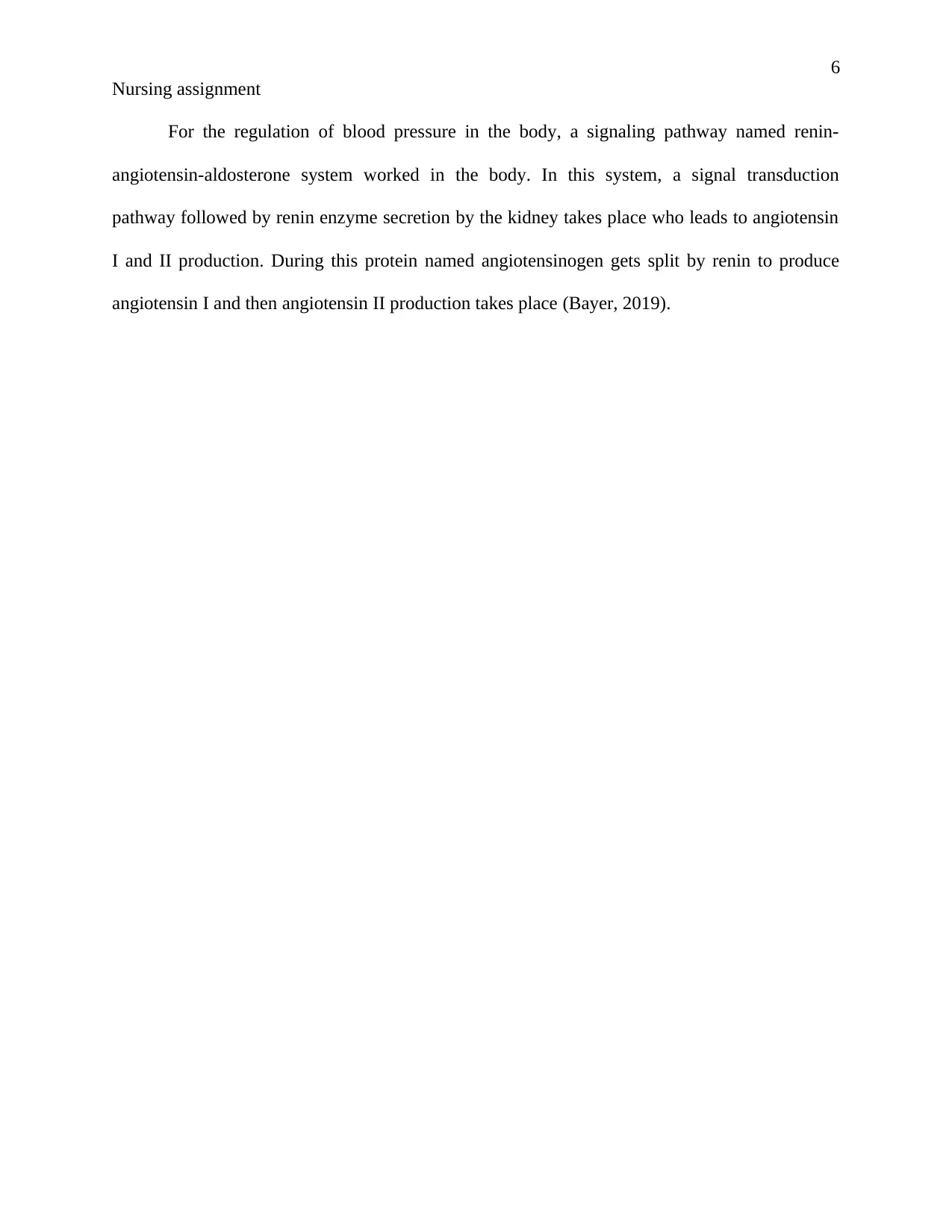
6
Nursing assignment
For the regulation of blood pressure in the body, a signaling pathway named renin-
angiotensin-aldosterone system worked in the body. In this system, a signal transduction
pathway followed by renin enzyme secretion by the kidney takes place who leads to angiotensin
I and II production. During this protein named angiotensinogen gets split by renin to produce
angiotensin I and then angiotensin II production takes place (Bayer, 2019).
Nursing assignment
For the regulation of blood pressure in the body, a signaling pathway named renin-
angiotensin-aldosterone system worked in the body. In this system, a signal transduction
pathway followed by renin enzyme secretion by the kidney takes place who leads to angiotensin
I and II production. During this protein named angiotensinogen gets split by renin to produce
angiotensin I and then angiotensin II production takes place (Bayer, 2019).
Paraphrase This Document
Need a fresh take? Get an instant paraphrase of this document with our AI Paraphraser
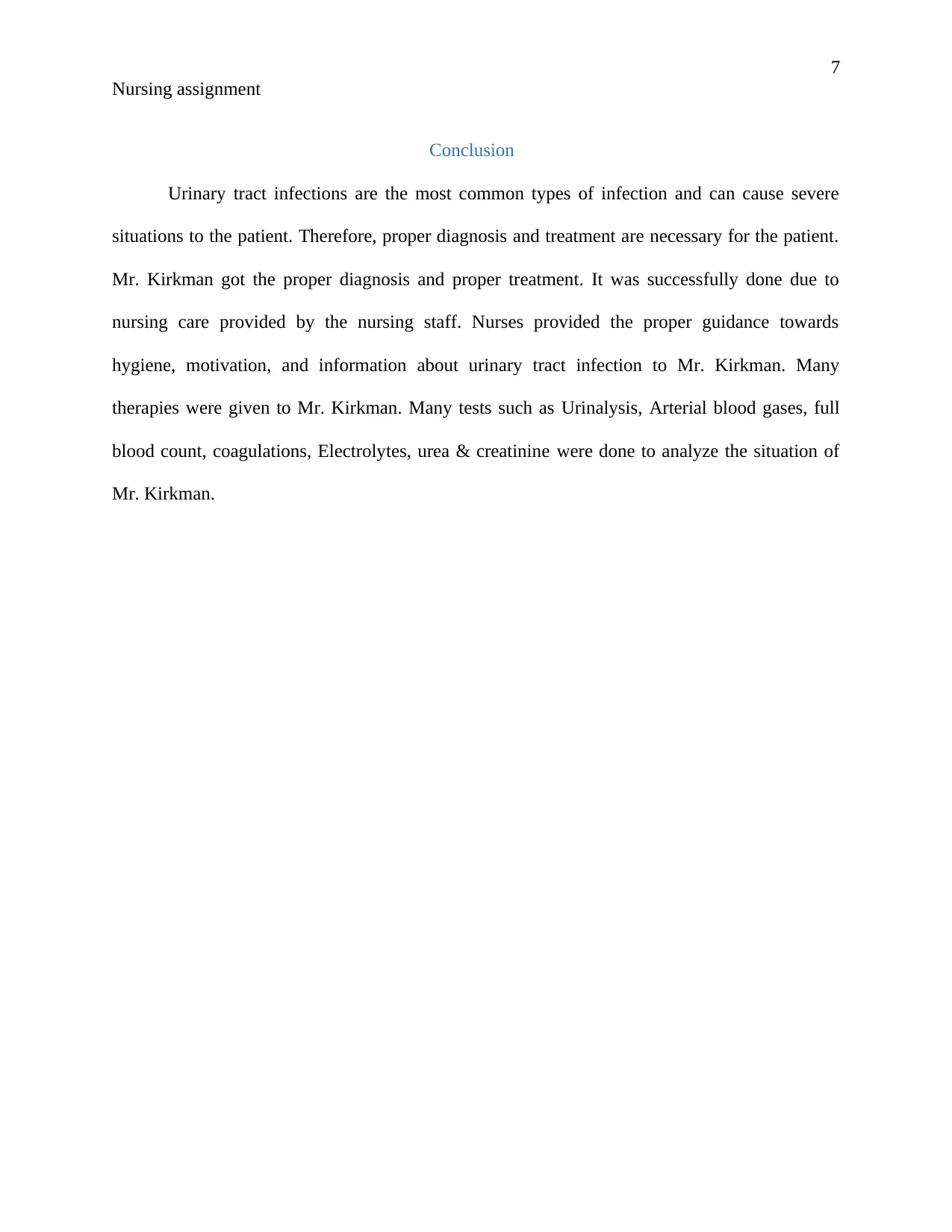
7
Nursing assignment
Conclusion
Urinary tract infections are the most common types of infection and can cause severe
situations to the patient. Therefore, proper diagnosis and treatment are necessary for the patient.
Mr. Kirkman got the proper diagnosis and proper treatment. It was successfully done due to
nursing care provided by the nursing staff. Nurses provided the proper guidance towards
hygiene, motivation, and information about urinary tract infection to Mr. Kirkman. Many
therapies were given to Mr. Kirkman. Many tests such as Urinalysis, Arterial blood gases, full
blood count, coagulations, Electrolytes, urea & creatinine were done to analyze the situation of
Mr. Kirkman.
Nursing assignment
Conclusion
Urinary tract infections are the most common types of infection and can cause severe
situations to the patient. Therefore, proper diagnosis and treatment are necessary for the patient.
Mr. Kirkman got the proper diagnosis and proper treatment. It was successfully done due to
nursing care provided by the nursing staff. Nurses provided the proper guidance towards
hygiene, motivation, and information about urinary tract infection to Mr. Kirkman. Many
therapies were given to Mr. Kirkman. Many tests such as Urinalysis, Arterial blood gases, full
blood count, coagulations, Electrolytes, urea & creatinine were done to analyze the situation of
Mr. Kirkman.

8
Nursing assignment
References
Abraham, S. N., & Miao, Y. (2015, October). The nature of immune responses to urinary tract
infections. US National Library of Medicine National Institutes of Health, 15(10), 655-
663. doi: 10.1038/nri3887
Bayer, P. (2019). The renin-angiotensin-aldosterone system (RAAS). Retrieved from
Pharmaceuticals Bayer Website:
http://pharma.bayer.com/en/innovation-partnering/research-and-development-areas/
cardiovascular/the-raas-system/
Davis, N. F., & Flood, H. D. (2011). The Pathogenesis of Urinary Tract Infections. In N. &. F.,
Clinical Management of Complicated Urinary Tract Infection (pp. 101-120).
doi:10.5772/22308
McLellan, L. K., & Hunstad, D. A. (2017, November 1). Urinary Tract Infection: Pathogenesis
and Outlook. US National Library of Medicine National Institutes of Health, 22(11), 946-
957. doi:10.1016/j.molmed.2016.09.003
Mikel, G. (2004, January/February). What Nursing Interventions Reduce the Risk of
Symptomatic Urinary Tract Infection in the Patient With an Indwelling Catheter?
Journal of Wound, Ostomy and Continence Nursing, 31(1), 3-13 [Free].
Ratini, M. (2017, October 04). What Is an Arterial Blood Gas Test? Retrieved from WebMD
Web site: https://www.webmd.com/lung/arterial-blood-gas-test#1
Ribeiro, S. (2015). Nursing management of urinary tract infections. ResearchGate, 27(7).
doi:10.7748/nop.27.7.24.e727
Rull, G., & Bonsall, A. (2017, August 22). Arterial Blood Gases. Retrieved from Patient
Website: https://patient.info/treatment-medication/arterial-blood-gases
Sepsis Alliance Website. (2017, December 14). Sepsis and Urinary Tract Infections. Retrieved
from Sepsis Alliance: Suspect Sepsis. Save Lives Web site:
https://www.sepsis.org/sepsis-and/urinary-tract-infections/
website, S. (2017). Sulfamethoxazole and Trimethoprim. Retrieved from Sydney Local Health
District Web site:
https://www.slhd.nsw.gov.au/RPA/neonatal%5Ccontent/pdf/Medications_Neomed/
Bactrim_Neomed.pdf
Nursing assignment
References
Abraham, S. N., & Miao, Y. (2015, October). The nature of immune responses to urinary tract
infections. US National Library of Medicine National Institutes of Health, 15(10), 655-
663. doi: 10.1038/nri3887
Bayer, P. (2019). The renin-angiotensin-aldosterone system (RAAS). Retrieved from
Pharmaceuticals Bayer Website:
http://pharma.bayer.com/en/innovation-partnering/research-and-development-areas/
cardiovascular/the-raas-system/
Davis, N. F., & Flood, H. D. (2011). The Pathogenesis of Urinary Tract Infections. In N. &. F.,
Clinical Management of Complicated Urinary Tract Infection (pp. 101-120).
doi:10.5772/22308
McLellan, L. K., & Hunstad, D. A. (2017, November 1). Urinary Tract Infection: Pathogenesis
and Outlook. US National Library of Medicine National Institutes of Health, 22(11), 946-
957. doi:10.1016/j.molmed.2016.09.003
Mikel, G. (2004, January/February). What Nursing Interventions Reduce the Risk of
Symptomatic Urinary Tract Infection in the Patient With an Indwelling Catheter?
Journal of Wound, Ostomy and Continence Nursing, 31(1), 3-13 [Free].
Ratini, M. (2017, October 04). What Is an Arterial Blood Gas Test? Retrieved from WebMD
Web site: https://www.webmd.com/lung/arterial-blood-gas-test#1
Ribeiro, S. (2015). Nursing management of urinary tract infections. ResearchGate, 27(7).
doi:10.7748/nop.27.7.24.e727
Rull, G., & Bonsall, A. (2017, August 22). Arterial Blood Gases. Retrieved from Patient
Website: https://patient.info/treatment-medication/arterial-blood-gases
Sepsis Alliance Website. (2017, December 14). Sepsis and Urinary Tract Infections. Retrieved
from Sepsis Alliance: Suspect Sepsis. Save Lives Web site:
https://www.sepsis.org/sepsis-and/urinary-tract-infections/
website, S. (2017). Sulfamethoxazole and Trimethoprim. Retrieved from Sydney Local Health
District Web site:
https://www.slhd.nsw.gov.au/RPA/neonatal%5Ccontent/pdf/Medications_Neomed/
Bactrim_Neomed.pdf
1 out of 9
Related Documents
Your All-in-One AI-Powered Toolkit for Academic Success.
+13062052269
info@desklib.com
Available 24*7 on WhatsApp / Email
![[object Object]](/_next/static/media/star-bottom.7253800d.svg)
Unlock your academic potential
© 2024 | Zucol Services PVT LTD | All rights reserved.





